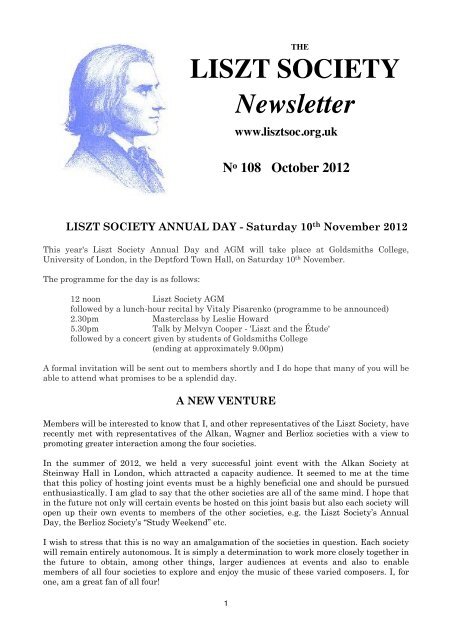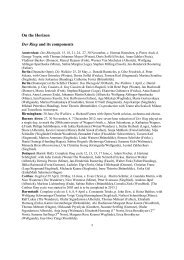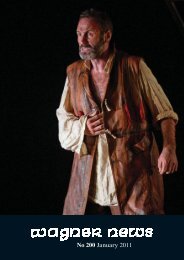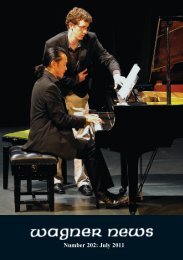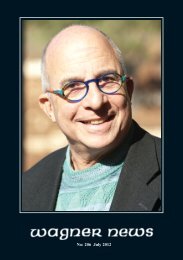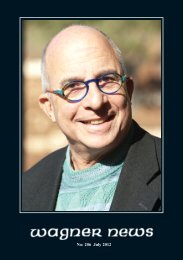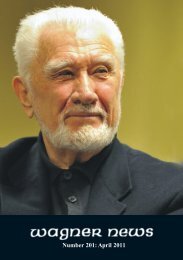LisztSoc Newsletter 108 (draft) - Wagner Society of England
LisztSoc Newsletter 108 (draft) - Wagner Society of England
LisztSoc Newsletter 108 (draft) - Wagner Society of England
Create successful ePaper yourself
Turn your PDF publications into a flip-book with our unique Google optimized e-Paper software.
LISZT SOCIETY ANNUAL DAY - Saturday 10 th November 2012<br />
This year's Liszt <strong>Society</strong> Annual Day and AGM will take place at Goldsmiths College,<br />
University <strong>of</strong> London, in the Deptford Town Hall, on Saturday 10 th November.<br />
The programme for the day is as follows:<br />
THE<br />
LISZT SOCIETY<br />
12 noon Liszt <strong>Society</strong> AGM<br />
followed by a lunch-hour recital by Vitaly Pisarenko (programme to be announced)<br />
2.30pm Masterclass by Leslie Howard<br />
5.30pm Talk by Melvyn Cooper - 'Liszt and the Étude'<br />
followed by a concert given by students <strong>of</strong> Goldsmiths College<br />
(ending at approximately 9.00pm)<br />
A formal invitation will be sent out to members shortly and I do hope that many <strong>of</strong> you will be<br />
able to attend what promises to be a splendid day.<br />
A NEW VENTURE<br />
Members will be interested to know that I, and other representatives <strong>of</strong> the Liszt <strong>Society</strong>, have<br />
recently met with representatives <strong>of</strong> the Alkan, <strong>Wagner</strong> and Berlioz societies with a view to<br />
promoting greater interaction among the four societies.<br />
In the summer <strong>of</strong> 2012, we held a very successful joint event with the Alkan <strong>Society</strong> at<br />
Steinway Hall in London, which attracted a capacity audience. It seemed to me at the time<br />
that this policy <strong>of</strong> hosting joint events must be a highly beneficial one and should be pursued<br />
enthusiastically. I am glad to say that the other societies are all <strong>of</strong> the same mind. I hope that<br />
in the future not only will certain events be hosted on this joint basis but also each society will<br />
open up their own events to members <strong>of</strong> the other societies, e.g. the Liszt <strong>Society</strong>’s Annual<br />
Day, the Berlioz <strong>Society</strong>’s “Study Weekend” etc.<br />
I wish to stress that this is no way an amalgamation <strong>of</strong> the societies in question. Each society<br />
will remain entirely autonomous. It is simply a determination to work more closely together in<br />
the future to obtain, among other things, larger audiences at events and also to enable<br />
members <strong>of</strong> all four societies to explore and enjoy the music <strong>of</strong> these varied composers. I, for<br />
one, am a great fan <strong>of</strong> all four!<br />
1<br />
<strong>Newsletter</strong><br />
www.lisztsoc.org.uk<br />
N o <strong>108</strong> October 2012
It has been decided to hold a dinner/recital on the 24 th January 2013 to celebrate this new<br />
venture and to provide an opportunity for members <strong>of</strong> all four societies to meet, exchange<br />
views, enjoy some splendid music and a top class dinner. I sincerely hope Liszt <strong>Society</strong><br />
members will support this venture as strongly as possible by attending this inaugural dinner/<br />
recital which promises to be a superb occasion. Fuller details <strong>of</strong> the event are to be found in<br />
the “Forthcoming Events” section <strong>of</strong> this newsletter and I will be issuing formal invitations to<br />
members for both this and the Annual Day in the near future.<br />
Please do give the dinner/recital your full support so that the evening is a real celebration <strong>of</strong><br />
the Liszt <strong>Society</strong> Council’s commitment to a successful, fulfilling and collaborative future!<br />
RECENT PUBLICATIONS<br />
The Untold Story <strong>of</strong> Adele aus der Ohe: From a Liszt Student to a Virtuoso<br />
LaWayne Leno Beaver’s Pond Press<br />
Jim Vincent<br />
Membership Secretary<br />
American author LaWayne Leno tells, for the first time, in a new book published in April,<br />
2012, the story <strong>of</strong> Adele aus der Ohe. She was one <strong>of</strong> Liszt’s most important students during<br />
his later years in Weimar, and one <strong>of</strong> the most successful pianists <strong>of</strong> the 19 th century. This<br />
first-ever biography is, in addition to a celebration <strong>of</strong> the 2011 bicentennial <strong>of</strong> Franz Liszt, also<br />
a celebration <strong>of</strong> the 150 th birth year <strong>of</strong> Adele aus der Ohe.<br />
Renowned Liszt scholar Alan Walker has praised the book saying, “Mr. Leno must be thanked<br />
for bringing Adele aus der Ohe out <strong>of</strong> the shadows…through his highly readable biography.”<br />
Donald Manildi, curator <strong>of</strong> the International Piano Archives at the University <strong>of</strong> Maryland<br />
called the book, “A fascinating, inspiring, and well-documented narrative about the life and<br />
career <strong>of</strong> a major figure in the annals <strong>of</strong> pianism…” Pianist Alexandre Dossin declared the<br />
book, “… a most welcome addition to the Lisztian bibliography. This well-documented easy-toread<br />
book brings to life a fascinating musician.”<br />
Adele aus der Ohe was an important musical figure and participated in some <strong>of</strong> the most<br />
notable musical events <strong>of</strong> her day. She was frequently called upon when an occasion required<br />
an especially significant performance. In London aus der Ohe participated in the Diamond<br />
Jubilee concert honoring 60 years <strong>of</strong> Queen Victoria’s reign, performing both the Schumann<br />
and the Liszt E-flat piano concertos in the same program. When Carnegie Hall in New York<br />
City was dedicated, the finest musicians <strong>of</strong> the day were engaged for the opening festivities:<br />
Tchaikovsky as conductor and aus der Ohe as soloist. Aus der Ohe and Tchaikovsky became<br />
friends and he invited her to St Petersburg to perform his B-flat minor concerto at the same<br />
concert that featured the premier <strong>of</strong> his Pathétique symphony, which sadly turned out to be<br />
Tchaikovsky’s final performance. When renowned conductor Theodore Thomas established the<br />
Chicago Symphony Orchestra, he engaged aus der Ohe for the opening season and when the<br />
Minneapolis Symphony (later renamed Minnesota Orchestra) was founded, aus der Ohe was<br />
engaged to perform her signature concerto, the Liszt E-flat concerto, in the opening season.<br />
Aus der Ohe was born in Hanover, Germany, and played her orchestral debut at the age <strong>of</strong> 10.<br />
She became Liszt’s student at the age <strong>of</strong> 12 and continued to study with him the rest <strong>of</strong> his<br />
life. Her concert tours took her throughout Europe and America, as far east as St Petersburg,<br />
and as far west as San Francisco. A favorite <strong>of</strong> the Boston Symphony, she performed with this<br />
venerable orchestra an astonishing fifty-one times. She was a composer as well as a friend and<br />
champion <strong>of</strong> many <strong>of</strong> the leading composers <strong>of</strong> her day, including Amy Beach, Edward<br />
2
MacDowell, Arthur Foote, and Henry Holden Huss. Her works were published by G. Schirmer<br />
in New York and Ries & Erler in Germany.<br />
In her later years she lived and taught in Berlin, where she faced the hardships <strong>of</strong> the First<br />
World War and the Great Inflation that followed. Late in her life she befriended Sergei<br />
Rachmanin<strong>of</strong>f through a series <strong>of</strong> letters that passed between them. She died in 1937.<br />
This compelling story <strong>of</strong> one <strong>of</strong> the greatest pianists <strong>of</strong> all time incorporates many <strong>of</strong> the<br />
writings <strong>of</strong> the day. The newspaper and magazine articles, letters, poetry, and various other<br />
commentary <strong>of</strong> the late nineteenth and early twentieth century give a wonderful sense <strong>of</strong> an<br />
age <strong>of</strong> sophistication and elegance that is long gone. Adele aus der Ohe was very much a<br />
woman <strong>of</strong> her time: a woman <strong>of</strong> refinement and dignity; a woman <strong>of</strong> principles and courage, <strong>of</strong><br />
exquisite manners and politeness; and an astonishingly successful concert pianist.<br />
The book is published in the United States by Beaver’s Pond Press and can be purchased<br />
online from adeleausderohe.com, or from amazon.com and amazon.co.uk<br />
Music in 1853: A Biography <strong>of</strong> a Year<br />
Hugh Macdonald Boydell & Brewer<br />
I have been approached by the publishers Boydell & Brewer with information about a new<br />
book from Hugh MacDonald and a special discount <strong>of</strong>fer for Liszt <strong>Society</strong> members.<br />
Music in 1853 shows how musicians were now more closely connected than ever before,<br />
through the constant exchange <strong>of</strong> letters and the rapidly expanding railway network. The<br />
book links geography and day-to-day events to show how international the European musical<br />
scene had become. A larger picture emerges <strong>of</strong> a shift in musical scenery, from the world <strong>of</strong> the<br />
innocent Romanticism <strong>of</strong> Berlioz and Schumann to the more potent musical politics <strong>of</strong> <strong>Wagner</strong><br />
and <strong>of</strong> his antidote (as many saw him) Brahms. As one might expect, Liszt features<br />
prominently.<br />
The book is <strong>of</strong>fered to Liszt <strong>Society</strong> members at the reduced price <strong>of</strong> £18.75 GB (RRP £25 GB)<br />
and can be ordered from Boydell & Brewer in the following ways:<br />
• Online at: www.boydellandbrewer.com<br />
(add title the to your shopping basket and quote <strong>of</strong>fer code 12181 when you check out)<br />
• By post to Boydell & Brewer Ltd, PO Box 9, Woodbridge, Suffolk, IP12 3DF<br />
• By telephone: 01394 610 600<br />
• Or via e-mail: trading@boydell.co.uk<br />
Postage is free for online orders.<br />
Postage for non-online orders: UK £3.00 per copy, Europe £6.50, Rest <strong>of</strong> the World £10.00.<br />
In all instances, please quote <strong>of</strong>fer code 12181 when ordering.<br />
The <strong>of</strong>fer is valid until 31 st December 2012.<br />
3<br />
Jim Vincent
CD REVIEW<br />
Liszt and the Devil Regulus RGCD-1030<br />
Pascal Devoyon, Rikako Murata - pianos 69’53”<br />
Over the last few years, and more especially prior to Liszt’s 200 th anniversary last year, I have<br />
been badgering various record companies to record Liszt’s unrecorded 4 hand and 2 piano<br />
works. Sadly, as yet, I have had no success. So it came as something <strong>of</strong> a surprise to find a<br />
recording <strong>of</strong> one <strong>of</strong> the works which I had hitherto thought had not been recorded - the 4 hand<br />
version <strong>of</strong> the Mephisto Waltz No. 2 (S600) - on a CD entitled Liszt and the Devil performed by<br />
pianists Pascal Devoyon and his wife, Rikako Murata. Most <strong>of</strong> the disc is taken up with the 2<br />
piano / 4 hand version <strong>of</strong> the Faust Symphony (S647 - <strong>of</strong> which I now know <strong>of</strong> 4 recordings).<br />
Unfortunately, this disc seems to have been produced in Japan which means buying it on<br />
import could prove to be expensive, unless you can find a second hand copy somewhere.<br />
The disc begins with the Faust Symphony, shorn <strong>of</strong> the choral ending (like all except one <strong>of</strong><br />
the recordings <strong>of</strong> this work in this arrangement). The first movement, a depiction <strong>of</strong> Faust, is<br />
taken at a more rapid pace than any <strong>of</strong> the other 3 recordings I have in my collection - it is<br />
almost 4 minutes faster than the slowest (by Vittorio Brescianai and Tiziano Poli, on Nuovo<br />
Era). This speed has the effect <strong>of</strong> creating some really exciting music - especially when the<br />
main triumphant theme (the so-called “Pride” motif) emerges from the quiet section preceding<br />
it. There is considerable virtuosity on display here and the whole movement is extremely well<br />
played and holds together very well. Of course, it is not all about the speed and things slow<br />
down considerably for the second movement, a depiction <strong>of</strong> Gretchen. This piece is here, as<br />
well as in the orchestral version, very delicately rendered. Interestingly here, the performance<br />
is slightly slower than one <strong>of</strong> the other recordings (from Naxos - with Vittorio Brescianai and<br />
Francesco Nicolosi - the only recording I know <strong>of</strong> with the choral ending included). The edgy<br />
central section is slightly disturbing (as it should be) prior to the main theme emerging before<br />
the piece comes to a quiet close. Finally, the last movement is given over to a depiction <strong>of</strong><br />
Mephistopheles. As is well known, Liszt gives the Devil no new tunes <strong>of</strong> his own and all <strong>of</strong> the<br />
themes are corrupted versions <strong>of</strong> those found in the first movement (aside from the quotation<br />
from the Malediction concerto). Here again, the performance is tremendously fast and very<br />
exciting but holds together very well. I would say that this duo is very well in tune with each<br />
other! The ending is Liszt’s own, ending noisily in C major having gone through several<br />
changes <strong>of</strong> key. Overall, this is a really exciting and splendid recording <strong>of</strong> this work and is well<br />
worth a listen if you can get hold <strong>of</strong> a copy.<br />
As I said earlier, next follows a real rarity - the Second Mephisto Waltz for 4 hands.<br />
Obviously, here as there are twenty fingers working rather than ten utilised in the solo<br />
version, there is more room for filigree ornamentation and octave doubling. Liszt certainly<br />
makes full use <strong>of</strong> all twenty fingers in this version! Structurally, there is little difference<br />
between this and the solo version but the additional “spare” fingers add more colours and a<br />
different perspective to the solo version. It was interesting to note the differences between<br />
these versions, here towards the end Liszt actually pares down the texture to a single octave<br />
rather than amplifying it as you might expect; the effect is rather a shock if you know the solo<br />
version. This is another really exciting performance - very well played and suitably demonic.<br />
To sum up, a very exciting disc <strong>of</strong> rare works, well worth a listen if you can get hold <strong>of</strong> a copy!<br />
4<br />
Jonathan Welsh
CONCERT REVIEWS<br />
Olivia Sham - Liszt and the Art <strong>of</strong> Remembering<br />
15 th June 2012 at the Piano Gallery, Royal Academy <strong>of</strong> Music Museum, London<br />
I had never before been to the Royal Academy <strong>of</strong> Music Museum but I can say without<br />
hesitation that it is well worth a visit. This small and beautifully designed museum is blessed<br />
with a quite superb collection <strong>of</strong> instruments - mainly stringed and keyboard instruments -<br />
and many very interesting scores, letters and documents. Among the instruments on display<br />
in the Piano Gallery is a lovely 1840 piano made by the Erard firm (a make that Liszt<br />
especially liked) and a 1920’s Steinway. It was on these two pianos that Olivia Sham gave<br />
what turned out to be a highly enjoyable and fascinating Liszt recital.<br />
The theme <strong>of</strong> the programme was “remembering” and so, as one might expect, the Valse<br />
Oubliées Nos. 1-4 featured prominently alongside such works as Ricordanza ,En Rêve and<br />
Liebesträume No. 2.<br />
Among a very full programme, Olivia also played two further Transcendental Studies (Eroica<br />
and Wilde Jagd) and a number <strong>of</strong> late pieces such as Schlaflos, Frage und Antwort,<br />
Trauervorspiel und Trauermarsch and Bagatelle ohne Tonart. The rarity <strong>of</strong> the evening was a<br />
performance <strong>of</strong> Liszt’s transcription <strong>of</strong> Berlioz’s Marche du Supplice from the Symphonie<br />
fantastique.<br />
It is absolutely clear that Olivia Sham is a player <strong>of</strong> very high calibre. She combines a virtuoso<br />
technique with a great deal <strong>of</strong> musicianship and sensitivity and is still only a young player,<br />
engaged, I believe, in studying for her doctorate at the Royal Academy. As she matures as an<br />
artist I am sure she will plumb even greater depths <strong>of</strong> expression and subtlety. If members<br />
have the chance to hear her in the future then I certainly recommend they take that<br />
opportunity!<br />
It was absolutely fascinating to hear many <strong>of</strong> the pieces played upon the Erard piano, which<br />
was quite a small piano with a most beautiful delicacy and warmth <strong>of</strong> tone, and to realize that<br />
during Liszt’s performing career he would have been playing on pianos such as this (or even<br />
earlier ones, <strong>of</strong> course). This shed a whole new light on Liszt and the Lisztian tradition. We<br />
have become so used to hearing Liszt’s music <strong>of</strong>ten played thunderously on enormous concert<br />
grands that we forget that the music would not have sounded like this under Liszt’s own<br />
hands. One has to completely revise one’s view <strong>of</strong> Liszt as a player and as a composer.<br />
To emphasize this point I might mention that I briefly chatted to a fellow member <strong>of</strong> the<br />
audience afterwards who said that he “normally couldn’t stand this stuff” (i.e. Liszt’s music)<br />
but hearing it played on the Erard had opened his ears to much <strong>of</strong> its beauties and he had<br />
thoroughly enjoyed the recital.<br />
Surely there could be no greater tribute to Olivia Sham’s vision in putting this programme<br />
together and to her fine playing.<br />
I understand that Olivia intends to record this programme as part <strong>of</strong> her doctorate studies and<br />
I will let members know if and when this is commercially available.<br />
5<br />
Jim Vincent
Schubert, Alkan and Liszt - Leslie Howard<br />
27 th June 2012 at Steinway Hall, London<br />
There was a capacity audience for this joint Alkan <strong>Society</strong> and Liszt <strong>Society</strong> event. And no<br />
wonder! The splendid programme comprised Schubert’s Fantasie in C major “Der Wanderer”,<br />
D760, Alkan’s Trois Petities Fantaisies, opus 41, and Liszt’s Grosses Konzertsolo, S176.<br />
Unfortunately, this having been one <strong>of</strong> the hottest days <strong>of</strong> the year, the Steinway Hall was like<br />
an inferno. This was taxing enough for the audience but what it must have been like for the<br />
pianist is another matter! Nonetheless, Leslie Howard gave an inspired performance <strong>of</strong> these<br />
three highly demanding works, introducing each <strong>of</strong> the pieces with fascinating remarks which<br />
revealed his usual erudition and passion for the music.<br />
It was particularly interesting to hear Leslie expound on Liszt’s views on some <strong>of</strong> the technical<br />
hurdles faced by the pianist in Schubert’s “Wanderer”. Schubert was not a great pianist and<br />
some <strong>of</strong> the fingerwork in this piece is so awkward that Liszt himself thought parts <strong>of</strong> it were<br />
unplayable. Hence, Liszt’s own version <strong>of</strong> the piece which makes these passages lie much<br />
better under the hand. As Leslie remarked, pianists nowadays adopt a “devil may care”<br />
attitude and play it as Schubert wrote it.<br />
It was similarly enthralling to hear about some <strong>of</strong> the technical demands made by Alkan<br />
(another very great pianist) in his short fantasies. These pieces display many <strong>of</strong> the<br />
extraordinarily original features <strong>of</strong> Alkan’s piano writing. They could really have been written<br />
by no other composer and one was amazed, as always, at the uniqueness <strong>of</strong> his ideas and<br />
methods. Possibly, this was a consequence <strong>of</strong> living a good part <strong>of</strong> his life almost as a recluse<br />
and having little contact with the outside world.<br />
Before the Liszt work, Leslie enlarged upon the very complicated history <strong>of</strong> the Grosses<br />
Konzertsolo, which is a forerunner <strong>of</strong> the more-<strong>of</strong>ten played sonata. Why the Grosses<br />
Konzertsolo is not performed more regularly I cannot imagine because it is a superb piece.<br />
Great as the sonata is, how refreshing it would be if more pianists programmed the<br />
Konzertsolo in their programmes in place <strong>of</strong> the ubiquitous sonata.<br />
It only remains to say that Leslie was on top form and played the programme with<br />
tremendous verve and brilliance coupled with sensitivity and musicianship. It was a privilege<br />
to be able to attend such an intimate recital as a member <strong>of</strong> the Liszt <strong>Society</strong>.<br />
Dear Sir,<br />
MEMBERS’ LETTERS<br />
Jim Vincent<br />
I have been a member <strong>of</strong> the Liszt <strong>Society</strong> for over twenty seven years and have a complete<br />
stock <strong>of</strong> Liszt <strong>Society</strong> Journals and Music Sections from those years. Now living in a small flat<br />
in Reigate, Surrey, I find that I need to have a “thinning out” session and wish to pass on my<br />
collection <strong>of</strong> journals to someone who would appreciate them. Would any member like to<br />
acquire these?<br />
If so, please do contact me on anthony.ricketts@gmail.com<br />
Kind regards,<br />
Anthony Ricketts<br />
6
Dear Sir,<br />
As former members <strong>of</strong> the Liszt <strong>Society</strong>, we are downsizing and would like to find homes for<br />
the following collection <strong>of</strong> books and recordings. Would any <strong>of</strong> your current members be<br />
interested?<br />
Alan Walker's biography pub Faber & Faber , Vol 1 the virtuoso years pub 1983 and Vol 2 the<br />
Weimar years pub 1989, in excellent condition with dustjackets. For £40 plus carriage we will<br />
throw in Liszt by Sacheverell Sitwell, Dover edn 1967 (paperback), and Liszt by Anthony<br />
Wilkinson pub McMillan 1975 , hardback with dustjacket.<br />
We also have a 34-tape archive which is card-indexed and includes around 150 pieces in the<br />
Searle catalogue <strong>of</strong> which many are the subject <strong>of</strong> interpretation by different artists, and<br />
which includes several pieces not in Searle. The Searle catalogue, 2 nd edn 1966 is included.<br />
95% <strong>of</strong> the recordings are good quality. Free to a good home at the cost <strong>of</strong> postage.<br />
We also have the following sheet music free to a good home for cost <strong>of</strong> postage -<br />
Liszt <strong>Society</strong> Publications: Vol. 2 - Early and Late Piano Works, Vol. 4 - Dances for Piano,<br />
Vol. 7 - Unfamiliar Piano Pieces; Henle edition, Annees de Pelerinage Vols. 1, 2 and 3, and the<br />
B minor Sonata; Edition Peters: Consolations & Liebestraume.<br />
We also have vinyls free to a good home at the cost <strong>of</strong> carriage: boxed sets <strong>of</strong> Liszt, one by<br />
Brendel and two by Claudio Arrau (including the amazing interpretation <strong>of</strong> the Etudes<br />
Transcendantes - one <strong>of</strong> which is scratched, sadly), 13 singles by Brendel, Jorges Bolet and<br />
others, plus Brendel's complete boxed set <strong>of</strong> Beethoven Sonatas.<br />
Please will members make contact with us direct if interested.<br />
Chris and Jill Burke [chris1burke@btinternet.com or phone 01395 579839]<br />
Sidmouth, Devon<br />
_______________________<br />
Dear Sir,<br />
A newsletter (The Eureka Report) established by Alan Kohler, a highly respected economics<br />
commentator, contained the following which I thought might be <strong>of</strong> interest:<br />
“I interviewed the CEO <strong>of</strong> the Australian Chamber Orchestra, Tim Calnin, this week and he<br />
told me about a fascinating but rather expensive investment asset: old instruments. Richard<br />
Tognetti, the first violinist and chief conductor <strong>of</strong> the ACO, plays a 1743 Guarneri del Gesu, on<br />
loan from an anonymous Australian benefactor (investor). It's worth more than $10 million<br />
and keeps going up because they are not making any more <strong>of</strong> them. Somebody else plays a<br />
1729 cello, on loan from Peter Weiss, and the 2nd violinist, Helena Rathbone, saws away at a<br />
1759 Guadagnini on loan from the Commonwealth Bank. Who knew the CBA was investing in<br />
violins?”<br />
Of more interest to you, perhaps, is that the ACO has an investment fund that allows smaller<br />
investors to part-own these historic instruments. The fund owns a $10 million 1728<br />
Stradivarius which is played by the assistant leader <strong>of</strong> the orchestra, Satu Vanska. He had<br />
better not drop it!<br />
Kind regards,<br />
John Godfrey<br />
Australia<br />
7
Dear Sir,<br />
Members may be interested to know that in the Autumn <strong>of</strong> 2011 a plaque was unveiled to<br />
commemorate Liszt’s visit to Liverpool in 1840. He performed in the former Theatre Royal (see<br />
illustration) on the 1 st December. The Theatre had been opened in 1772.<br />
In 1832 Paganini had performed his Third Violin Concerto at the Theatre Royal prior to<br />
performing the work in London.<br />
When Liszt arrived in Liverpool having crossed the Mersey by ferry, he walked for two miles<br />
out <strong>of</strong> Liverpool City Centre to view a huge American steamer called “The President” which<br />
had arrived and been greeted with great enthusiasm at the Coburg Dock.<br />
In the evening Liszt thrilled the audience at the Theatre Royal with a performance <strong>of</strong> Weber’s<br />
Konzertstück with the theatre’s own resident orchestra. The performance was the highlight <strong>of</strong><br />
the subscription series and was a great success.<br />
Judith Gore<br />
[Members may remember a photo <strong>of</strong> this plaque in <strong>Newsletter</strong> No. 105]<br />
Benjamin Kaplan<br />
Pianist and teacher<br />
September 23 rd 1929 - December 2 nd 2011<br />
OBITUARIES<br />
With the passing on 2 nd December 2011 <strong>of</strong> Benjamin Kaplan, the world <strong>of</strong> music and <strong>of</strong><br />
pianists has lost one <strong>of</strong> its most inspiring mentors and pedagogues. A fine pianist himself,<br />
recipient <strong>of</strong> the 1961 Liszt Prize, for the last three decades Kaplan dedicated himself to<br />
teaching, with many <strong>of</strong> his students reaching international careers.<br />
Kaplan was born in London to a musical family, his father Alf Kaplan being an accordionist in<br />
the well known dance band <strong>of</strong> Oscar Rabin, performing widely at such venues as the<br />
Hammersmith Palais. After WWII, Kaplan studied as an external student at the Guildhall<br />
School <strong>of</strong> Music (1946-9) with Frank Griggs, gaining his advanced diplomas (LGSM and<br />
8
AGSM), then was conscripted into the Army Education Corps (1949-51), posted in Trieste,<br />
where he studied with the Busoni pupil Angelo Kessissoglu. Returning to Britain he studied<br />
with the émigré German-Jewish Franz Reizenstein (1952-8) and then with the émigré<br />
Hungarian virtuoso Louis Kentner (59-64). Amongst his notable performances was the UK<br />
premiere <strong>of</strong> Humphrey Searle’s Concertante for Piano, Strings and Percussion, with the<br />
Goldsburgh Orchestra under Harry Samuel in October 1954, a performance the Musical Times<br />
described as a ‘rewarding initiation’ into twelve-tone music.<br />
In 1956 Kaplan gave his Wigmore Hall debut recital and in 1961 was a prize winner in the<br />
Liszt Competition, an award resulting in a recording for Pye Records praised by the<br />
Gramophone as “tasteful, fluent and emotionally restrained”.<br />
In the same year, 1961, Kaplan made his BBC Radio 3 debut broadcast, following which he<br />
gave numerous radio recitals for the BBC between 1960-1985, as well as for radio stations in<br />
Germany, Austria and Israel. Throughout his career chamber music played an influential role<br />
in Kaplan’s concertizing: with the violinist Leonard Friedman he travelled around Europe<br />
giving recitals, and also frequently partnered soloists and singers such as the violinists Maria<br />
Lidka and Alfredo Campoli, and, as part <strong>of</strong> the ‘Musica Intima’ ensemble, the noted alto Sybil<br />
Michelow and violist Christopher Wellington.<br />
Having taught children since his teenage years, from 1975 onwards Benjamin Kaplan<br />
increasingly devoted his time to teaching advanced students in <strong>England</strong>, the USA, Japan and<br />
Israel, where he was on the Faculty <strong>of</strong> the Tel-Hai International Piano Masterclasses. He held<br />
posts at the Guildhall School <strong>of</strong> Music and Drama, (1984-92) and at the Royal Academy <strong>of</strong><br />
Music (2005-8), and from 1980 onwards was associated with the Purcell School.<br />
One <strong>of</strong> Kaplan’s last public appearances was at the Reizenstein Centenary Symposium at the<br />
Royal Academy <strong>of</strong> Music in October 2011, where he recalled his own teacher’s deep insights<br />
into aspects <strong>of</strong> piano technique. Indeed during the course <strong>of</strong> his career Kaplan taught<br />
hundreds <strong>of</strong> young pianists and pr<strong>of</strong>essionals, many <strong>of</strong> his students winning international<br />
prizes including the Leeds, Queen Elisabeth (Brussels) and Kapell (USA). Amongst them are<br />
the acclaimed virtuosos Daniel Blumenthal and Mark Anderson, Noriko Ogawa and Kit<br />
Armstrong, and a long list <strong>of</strong> pianists including Carolyn Kotok and the well-known pedagogue<br />
Phyllis Lehrer.<br />
Kaplan taught in his piano studio in Hampstead Garden Suburb where he lived with his wife<br />
Naomie, whom he married in 1971, <strong>of</strong>ten joined by their two children and grandchildren. A<br />
keen sportsman and tennis player, he injected athletic energy into his teaching style, always<br />
conveying a sense <strong>of</strong> duty to the practical task <strong>of</strong> making-music, understanding his pupils<br />
needs and helping them realise their individual potentials.<br />
Benjamin Kaplan’s musical legacy may be sensed both in the wealth <strong>of</strong> broadcasts and<br />
recordings he made, and in his enduring influence as a teacher, a teacher’s teacher, and a<br />
mentor <strong>of</strong> leading concert pianists. Many former pupils, the present writer included, will recall<br />
his inspiration with gratitude and warm affection.<br />
9<br />
Malcolm Miller
Lord Londonderry<br />
September 7 th 1937 - June 20 th 2012.<br />
We were very sad to hear <strong>of</strong> the death <strong>of</strong> Lord Londonderry, who has been a Patron <strong>of</strong> the Liszt <strong>Society</strong><br />
for over 40 years. A general obituary was published in The Daily Telegraph in June and may be found<br />
readily online. This personal tribute has been written for the <strong>Newsletter</strong> by Leslie Howard.<br />
Alastair, the 9 th Marquess <strong>of</strong> Londonderry, was a noted Liszt enthusiast who had been a<br />
member <strong>of</strong> the Liszt <strong>Society</strong> from its early years. In 1965 he was invited to join the then<br />
‘Committee’ <strong>of</strong> the recently reconstituted <strong>Society</strong>. Louis Kentner had been invited to become<br />
President <strong>of</strong> the <strong>Society</strong> in succession to Edward Dent. At that time Robert Collet was<br />
chairman, and Sacheverell Sitwell was the newly-appointed Vice-President. Dr Vernon<br />
Harrison was the Treasurer and Dr Barry Goalby was the Secretary. William Walton and<br />
Humphrey Searle had been formally asked to remain on the new committee, having been part<br />
<strong>of</strong> the earlier one since the <strong>Society</strong>’s inception in 1951. Minutes <strong>of</strong> the Committee reveal that<br />
attempts to get a famous conductor to join had apparently fallen upon stony ground: Sir<br />
Adrian Boult, Leonard Bernstein and Sir Charles Groves were all approached in vain. The<br />
annual subscription had just been raised from five shillings to one pound! Liszt <strong>Society</strong><br />
Publications Volume 5 was being planned [it did not appear until 1968 thanks to delays at the<br />
publishers, Schott & Co.] as was the third <strong>Newsletter</strong>. [The <strong>Society</strong> does not appear to have<br />
copies <strong>of</strong> the early <strong>Newsletter</strong>s - forerunners to the Journal - from the first in 1961 to the last<br />
in 1970.] LS Publications Volumes 1-4 were all selling slowly but steadily. At the end <strong>of</strong> 1965,<br />
membership stood at 141, and the cash balance <strong>of</strong> the <strong>Society</strong> amounted to £240. 15s. 5d. By<br />
the end <strong>of</strong> 1969, the Liszt <strong>Society</strong> was in the throes <strong>of</strong> incorporation as a company, and<br />
registration as a charity. Alastair Londonderry had long dropped out <strong>of</strong> the committee, but<br />
was invited to become a Patron <strong>of</strong> the ‘new’ Liszt <strong>Society</strong> in 1970. The Liszt <strong>Society</strong> has<br />
remained an incorporated company and a registered charity ever since 1970, and is run by a<br />
Council <strong>of</strong> Management. Alastair Londonderry remained a Patron <strong>of</strong> the <strong>Society</strong> until his<br />
death in 2012.<br />
Alastair was a great friend to the Arts: an avid piano student with Egon Petri, a sometime<br />
music critic, a collector <strong>of</strong> manuscripts [including Liszt’s still-unpublished Grand Solo de<br />
concert for piano and orchestra] and rare editions, all <strong>of</strong> which he made available to young<br />
musicians in whom he took an interest - which would usually happen only if they were Liszt<br />
enthusiasts! He was a great support to John Ogdon, and later to the present writer. He also<br />
organised many a musical/balletic event to raise money for the World Wildlife Fund [during<br />
the time <strong>of</strong> his marriage to prima ballerina Doreen Wells], and he supported the Keyboard<br />
Charitable Trust. He was instrumental in getting his brother-in-law Lord Raine to join the<br />
<strong>Society</strong>’s Patrons, specifically to assist with the running <strong>of</strong> the piano competition in 1976.<br />
[I recall in my last student years going to his London house in South Kensington, practically<br />
on a daily basis, to practise on his Steinway B, to sight-read all manner <strong>of</strong> rare pieces he had<br />
collected, and to be introduced to many a great figure, including Sir Malcolm Arnold, whose<br />
2 nd Clarinet Concerto I helped prepare there with Benny Goodman - with whom I went on to<br />
give a number <strong>of</strong> performances in the USA. Alastair generously underwrote several <strong>of</strong> my<br />
early Wigmore Hall and Queen Elizabeth Hall recitals, including my treble London debut<br />
recitals <strong>of</strong> Liszt, Beethoven and Russian Sonatas in 1975.]<br />
10<br />
Leslie Howard
FORTHCOMING EVENT<br />
The Liszt <strong>Society</strong> Dinner - Thursday 24 th January 2013<br />
As many <strong>of</strong> you will know, the <strong>Society</strong> has been planning for some time to hold a dinner/recital<br />
celebrating the end <strong>of</strong> the Liszt bicentenary year. Originally it had been proposed to hold this<br />
in November/December 2012 but, on reflection, this was considered to be rather too near the<br />
<strong>Society</strong>’s Annual Day and the date <strong>of</strong> the event has accordingly been postponed until January.<br />
The <strong>Society</strong> has also recently approached the Alkan, <strong>Wagner</strong> and Berlioz societies with a view<br />
to much closer joint-working with these societies in the hope that, among other benefits, this<br />
will make it easier for all <strong>of</strong> these societies to achieve good sized audiences for events.<br />
Accordingly, an invitation to the Liszt <strong>Society</strong> dinner/recital will also be extended to members<br />
<strong>of</strong> these societies and the event, in addition to celebrating the Liszt bicentenary year, will be<br />
considered as an inaugural dinner/recital hailing the future commitment <strong>of</strong> all four societies to<br />
working together for the good <strong>of</strong> all.<br />
The venue will be The Forge, 3-7 Delaney Street,Camden Town London NW1 7NL<br />
(www.forgevenue.org), which has a delightful Sicllian restaurant and an excellent recital<br />
room. The ticket price will be £40 per head and will include a two-course meal (meat, fish and<br />
vegetarian options), wine, and the recital. Guests, <strong>of</strong> course, are very welcome.<br />
The recital will be given by the outstanding pianist, Mark Viner, and the programme is likely<br />
to include Liszt’s Hexamaron and Alkan’s Sonatine (and, hopefully, some Liszt transcriptions<br />
<strong>of</strong> <strong>Wagner</strong> and Berlioz works plus a performance <strong>of</strong> <strong>Wagner</strong>’s Liebestod from Tristan und<br />
Isolde with soprano - yet to be confirmed). It is expected that the recital will take place from<br />
7.00-8.00pm with dinner commencing at 8.15pm, although timings have not yet been finalized.<br />
A final word…<br />
Members will be interested to know that pianist Benjamin Grosvenor was awarded critics<br />
prize in the Classical Brit awards held at the Royal Albert Hall, London, on the 2 nd October<br />
2012. Although Benjamin is not himself a member <strong>of</strong> the Liszt <strong>Society</strong> we do have the pleasure<br />
<strong>of</strong> having his grandparents as members and accordingly feel a little <strong>of</strong> the reflected glory!<br />
The award was for his recording <strong>of</strong> works by Chopin, Liszt and Ravel (Decca 0289 478 32065).<br />
Liszt is represented on the disc by the short nocturne En Rève and by two transcriptions <strong>of</strong><br />
Chopin songs.<br />
Jim Vincent<br />
[This recording has since won the Instrumental category at the 2012 Gramophone Awards.]<br />
CONTACT DETAILS<br />
Letters for the <strong>Newsletter</strong>, Membership Applications and Renewals, and Enquiries:<br />
Jim Vincent, The Membership Secretary, The Liszt <strong>Society</strong><br />
3 Offlands Court, Moulsford, Oxon OX10 9EX United Kingdom<br />
Tel: +44 (0) 1491-651842<br />
memsec@lisztsoc.org.uk<br />
The Liszt <strong>Society</strong> is a Registered Charity No 261164<br />
Registered as a Limited Company No 977039<br />
Registered Office: 1a Hawthorne Drive, Evington, Leicester, LE5 6DL, UK<br />
11


